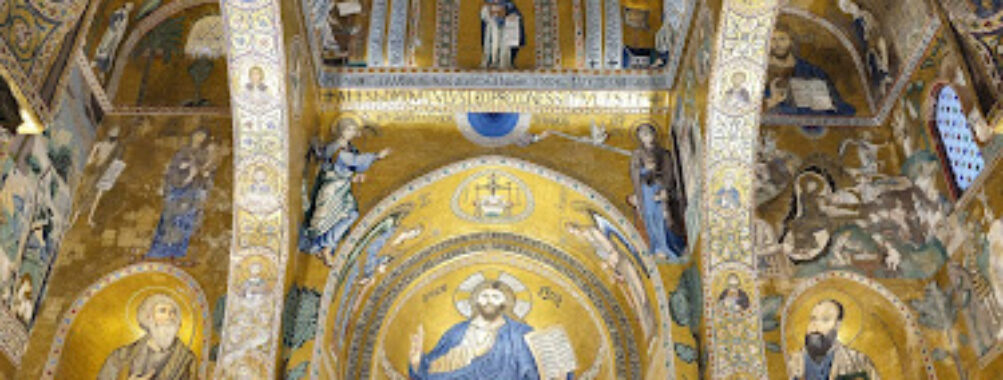
Royal Palace and Palatine Chapel
Table of Contents
Description
The Royal Palace and Palatine Chapel in Palermo is one of those places that quietly sneaks up on you. You think you’re just visiting another historical building, and then suddenly you’re standing under golden mosaics that shimmer like they’ve been lit from within. The chapel, built in the 12th century under King Roger II, is a rare fusion of Norman, Arab, and Byzantine artistry. It’s not just a church, not just a museum—it’s a layered story carved into stone, painted on wood, and glittering across every inch of its walls and ceilings.
Walking through, you’ll notice the mosaics first. They’re everywhere, depicting biblical tales in such vivid detail that even if you’re not particularly religious, you’ll find yourself pausing to trace the stories with your eyes. And then there’s the wooden ceiling, carved and painted in Islamic muqarnas style, which feels like stepping into another world entirely. It’s this mix—Christian devotion, Islamic artistry, and Norman ambition—that makes the chapel feel less like a monument and more like a conversation between cultures. Some visitors leave overwhelmed, others a little underwhelmed by the palace itself, but nearly everyone agrees the chapel is the soul of the complex.
Now, I’ll be honest: it can get crowded, especially when tour groups shuffle in. And sometimes you’ll have to crane your neck around someone’s selfie stick to catch a glimpse of the mosaics. But even then, it’s worth it. When the sunlight filters through the windows and the gold tiles catch the light, you’ll understand why people travel across the world to stand here. It’s one of those rare places where history doesn’t just sit quietly—it glows.
Key Features
- 12th-century Palatine Chapel with dazzling Byzantine mosaics
- Intricately carved Islamic-style wooden ceiling with human figures
- Royal Palace rooms showcasing Norman and later Spanish influences
- Access to the Royal Gardens and Punic Walls on certain days
- Onsite amenities including restrooms and wheelchair accessibility
- Audio guides available for deeper exploration
Best Time to Visit
If you can, aim for a weekday morning. That’s when the crowds are thinner, and you’ll actually have a chance to stand still and take it all in. Weekends and holidays tend to be busier, especially during the summer months when Palermo fills with tourists. Spring and autumn are my personal favorites—the weather is mild, the light is softer, and the city feels more relaxed. In winter, you’ll practically have the place to yourself, but keep in mind that shorter opening hours may limit your time inside.
One tip that’s worth repeating: go early. The chapel is small compared to the palace, and once it’s packed, it can feel a bit claustrophobic. Arriving right when it opens gives you those precious few minutes of quiet before the crowds arrive. And trust me, standing in that silence with the mosaics glowing around you is a memory you’ll carry long after you’ve left Sicily.
How to Get There
Reaching the Royal Palace and Palatine Chapel is fairly straightforward if you’re already in Palermo. The site sits right in the historic center, so you can walk from most major attractions in under 20 minutes. If walking isn’t your thing, local buses and taxis drop off nearby, and there’s a paid parking lot for those driving. Just keep in mind that Palermo traffic has a personality of its own—chaotic, loud, and not for the faint of heart. Personally, I’d skip the car and enjoy the stroll through the old streets, which is half the charm of being in this city.
For those with mobility needs, the entrance, parking, and restrooms are wheelchair accessible, which makes visiting less stressful. And if you’re relying on public transport, buses run frequently from the main train station and other parts of the city. It’s one of those attractions that’s easy to reach, so there’s really no excuse not to go.
Tips for Visiting
Here are a few things I wish I had known before my first visit:
- Buy tickets in advance if possible. It’ll save you from waiting in long lines, especially during peak season.
- Bring a scarf or light sweater. The chapel can feel surprisingly cool inside, even on hot days.
- Take your time. Don’t just snap pictures and move on. Sit down, look up, and let your eyes wander across the mosaics. The longer you look, the more details you’ll notice.
- Consider the audio guide. It’s inexpensive and adds a lot of context that you’d otherwise miss. Without it, you might not fully grasp the significance of what you’re seeing.
- Be respectful. Remember, this is still a sacred space for many. Keep your voice down and avoid flash photography.
- Plan for extra time. While the chapel is the highlight, the palace and gardens are worth exploring too. Don’t rush through them.
And one last personal note: don’t underestimate the emotional punch this place can deliver. I went in expecting to admire some pretty mosaics, and I walked out feeling like I had just witnessed a centuries-old dialogue between cultures. That blend of Norman power, Byzantine artistry, and Islamic craftsmanship is something you don’t find every day. It’s not perfect—nothing ever is—but it’s unforgettable. If you’re in Palermo, make this a priority on your list. You’ll thank yourself later.
Location
Places to Stay Near Royal Palace and Palatine Chapel
Find and Book a Tour
Explore More Travel Guides
No reviews found! Be the first to review!